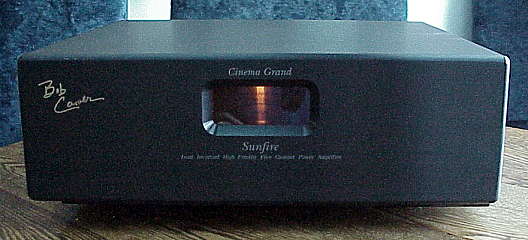Product Review - Sunfire Cinema Grand Signature Five-Channel Power Amplifier - September, 1999 - Updated November, 2001
 |
 |
Product Review - Sunfire Cinema
Grand Signature Five-Channel Power Amplifier - September, 1999 - Updated
November, 2001
John E. Johnson, Jr.
![]()
|
Sunfire Cinema Grand Signature Five-Channel Power Amplifier 405 Watts rms per Channel into 8 Ohms MFR: 1 Hz - 80 kHz Input Impedance: 24 kOhm Size: 6 1/2" H x 19" W x 16 3/4" D Weight: 43 pounds MSRP: $3,495 USA ($3,750 in 2001, See Below) |
| Sunfire Corporation,
5210 Bickford Avenue Snohomish, Washington 98290; Phone 425-335-4748; Fax 425-335-4746; Web http://www.sunfire.com. |
The first thing I want to say is, "This is not your Grandfather's amplifier." In those days, commercial movie theaters made do with 10 watts or less, and that was just with one channel. Those days are GONE! Underneath the hood of the Sunfire Cinema Grand Signature are more than 400 watts rms x 5, just waiting for you to make the windows shudder. Just waiting for your neighbor to make the big mistake of thinking his home theater is more powerful than yours.
The Signature is Bob Carver's latest addition to the Sunfire brand of hi-fi, and he told me he thinks it is his best work yet. After listening to it, I believe him.
Note: This product has been upgraded with a larger power supply. See November, 2001 review at bottom of page.
It looks like many of Sunfire's other products. Bob has always given his customers a huge bang for the buck, and by using the same chassis cover for several different products, with only the printed name of the model on the front being different, he saves money. And that saving gets passed on to us.
Another thing we save is energy. The Cinema Grand Signature uses a digital switching power supply (Class D), courtesy of Bob's Tracking Downconverter. This circuit maintains the rail voltage just 6 volts above the signal demands, and that makes the power supply very efficient . . . about 95%. In other words, it "tracks" the signal voltage and keeps the supply just above it. For the Sunfire, the tracking downconverter is making adjustments 130,000 times per second, which is more than 6 times per second at the top end of the audible spectrum (20 kHz). If this were not happening, the output transistors (8 per channel in the Signature) would have to dissipate, in heat (watts), the difference between the rail voltage and the signal voltage multiplied by the current flowing through those devices (voltage x current = watts). That makes Class A and Class A/B amplifiers get hot, because they use fixed rail voltages. Of course, there are many people who prefer the Class A and Class A/B amplifiers because adjusting the rail voltage while the music is playing can cause distortion. It could make the amplifier somewhat slower too. And, they are right. It could happen. However, digital switching amplifiers are getting better and better at not delivering distortion along with the music, and switching at higher and higher speed. Also, take a guess at what you might have to pay for a 400 watt x 5 Class A amplifier. Maybe add one decimal place to the right of the price for the Cinema Grand Signature. Maybe even bump the first number in the price up a notch or two. Every design has its problems, including Class A, Class A/B, and Class D. They all have their critics too. Especially Bob Carver, who over the years, has come up with some of the most ingenious designs in audio. (The real reason for his critics having at him is that he does not charge an arm and leg for the products, and that makes it difficult to compete with him.)
The Signature has filters to limit bandwidth to 80 kHz. Although this could cause some phase shift in the upper audible bands, it maintains stability with any speaker, even electrostatics. Also, we should keep in mind that when given 400 watts, virtually any speaker is going to produce more distortion than the amplifier, perhaps 10% or even more.
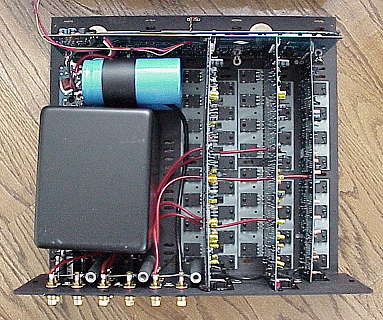 |
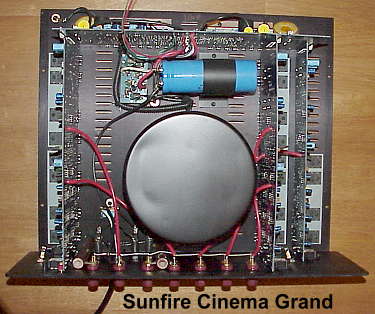 |
If you look inside the Signature (see photo above, top), you find the box filled with electronics. This compares with the original Sunfire Cinema Grand (photo above, bottom), which still had some space left. The Signature has a much larger power supply, with two 20,000 �F capacitors, and � 200 Volts on them, giving 800 Joules of energy storage (maximum). The original Cinema Grand had the same voltage, but two 9,300 �F capacitors, yielding 372 Joules. However, the Signature front panel meter reads a constant 480 Joules, which represents the content of the power supply that is necessary for proper functioning. The idea is that if the meter starts to drop from 480, then you are overdriving the amplifier. I never saw it budge, regardless of the volume, into 8 Ohm loads (five speakers). You can also see that, while the original Cinema Grand has a toroidal power transformer, the Signature has a square type (called an EI core transformer). A toroidal transformer powerful enough to deliver 400 watts per channel just would not fit in the Signature chassis.
Why, one might ask, does this amplifier need such a big power supply if it is so efficient? Well, don't forget, the Signature is designed to deliver 400 watts x 5. That requires a huge power supply no matter how efficient it is (unless the laws of thermodynamics and physics have been revised). There are 18 HEXFETS in the power supply to keep things rolling along. Because of the high efficiency, the amplifier always ran stone cold in my tests. One nice result is that I didn't have to keep sweeping cat hair off the top of the chassis. My cats like warm amplifiers, not cold ones. Over the long term, I would imagine the Signature lasting quite a number of years without problems, since solid state devices detest heat.
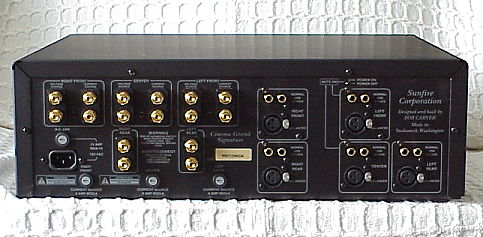 For
the output stage in each channel, there are 8 bipolar transistors (4 per channel
in the original Cinema Grand). Again, since one usually sees power transistors
rated at high voltage and high current, why so many if the tracking
downconverter is so efficient? This has to do with the Safe Operating Area (SOA)
assigned to the transistors. If high current, then low voltage. If high voltage,
then low current. So, for an amplifier designed to put out high voltage AND high
current, plenty of output transistors have to be in place, in parallel.
For
the output stage in each channel, there are 8 bipolar transistors (4 per channel
in the original Cinema Grand). Again, since one usually sees power transistors
rated at high voltage and high current, why so many if the tracking
downconverter is so efficient? This has to do with the Safe Operating Area (SOA)
assigned to the transistors. If high current, then low voltage. If high voltage,
then low current. So, for an amplifier designed to put out high voltage AND high
current, plenty of output transistors have to be in place, in parallel.
The rear panel of the Signature has all the connectors, including two RCA jacks and an XLR Balanced jack for each channel's inputs, five-way binding posts for each output (one set of voltage source and one set of current source for front left, center, and right), a small toggle on/off/auto switch, and the grounded AC receptacle. All input and output jacks are gold plated. Close ups of the two main sections on the rear panel are shown below. You can see that the auto-on feature is linked to the center and left front channels. This allows for when there is a mono signal that gets fed to the center when Pro Logic is employed, and when there is stereo, with sound in the front left and right channels.
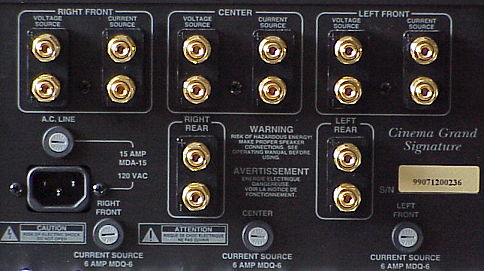 |
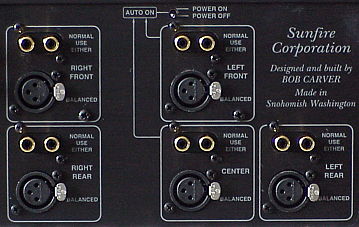 |
Inside the amplifier one can see three large 1 Ohm power resistors. Each one is in series with the current-source speaker output jacks. This is in keeping with Bob's theory that it is the high impedance output of tube amplifiers that gives them their sonic signature. I don't necessarily subscribe to this theory, thinking that there just HAS to be more to the tube sound than a high impedance output. But, I am not an engineer or a physicist. The bottom line is whether or not the resistors result in a different sound at those outputs, from the sound through the outputs that don't have the resistor (the voltage-source outputs). Yes, they do sound different. The current source outputs give a smoother sound, with a slightly laid back high frequency range. And, yes, that is one of the things that characterizes tube sound. But . . . I still think there has to be more to the tube sound than that. Let's just say that the current-source outputs deliver more of a tubey sound than you might ordinarily find in a solid state amplifier. And, I did like them. In fact, once I heard the difference, I settled on using the current-source outputs for all three front speakers. The reason is that movie sound tracks tend to be a little harsh. All that screaming and shooting that we get in today's films are very, very difficult to record without some distortion (overloading the microphone preamps). But, even with music, I liked the current-source outputs. I particularly enjoy Baroque classical music, which is laid back to a certain extent, and the current source sound just fits that type of music for me. I guess I am just a laid back kind of guy.
I tested this home theater monster with our Yamaha DSP-A1 as a 5.1 preamplifier, a Yamaha DVD-S700 DVD Player, Krix Speakers, and Nordost Cables.
I put on my favorite DVD for this sort of thing, namely "True Lies". Chapter 4 is where Arnie says, "Here is my invitation!" The next several minutes are filled with gut wrenching deep explosions and rapid machine gun fire. Every channel is alive with sound. Of course, just about any amplifier will handle it with the volume turned down, but what happens when it is cranked? I turned it up, and up, and up. Up until I reached 95 dB with a meter in the center of the room. The subwoofer started to clip, but the Sunfire kept on delivering. No harshness, no crackle, and it was clean.
Now, I know that I could have kept going with the volume control, but I didn't, because I want to use my ears another day. And this brings up an important point. Just because one has all that power does not mean that you have to listen at ear splitting levels all the time. Tinnitus is in your future if you do that. The real value in 400 watts per channel is still listening at humane levels (75 dB), but knowing that when the occasional transient demand is there, the amplifier will deliver. The front edges of all those explosions and gun shots demand a tremendous amount of power. So, keep the volume at a reasonable setting and be content. Your home theater is more powerful than your neighbor's. And if he says, well, I have 400 watts per channel too, you can tell him yours has 405 (you know that is why Bob made it 405, you just KNOW it). Also on the table were "Daylight" DTS DVD, and the "Aliens" DVD, redone for 5.1 DD. Of course, vanilla sound tracks of various movies I rented over the course of the review sounded good too. But it is the DVDs with sound so hot, they are made of asbestos, that really separated this amplifier from the wannabees.
With my 5.1 CDs and DVDs, such as Holst's "The Planets", I found the Signature to be very musical. The details were all there too. One of the reasons the Signature does well with the details is that it is a quiet amplifier. Very, very little hum and hiss. There are lots of reasons why a system may not reproduce the details. Presence of background noise is one of them. That is probably the main reason why fully balanced amplifiers sound so nice. No noise at all. The Sunfire Cinema Grand Signature has balanced inputs, but since the amplifier is so quiet with RCA inputs anyway, I decided not to use them.
In summary, now that digital surround sound for movies is the norm, and with DVD Audio on the visible horizon, it is important to have sufficient power in all channels to handle anything and everything. If you never listen to movies or music at levels that make your toes curl, then the built-in amplifiers of receivers are perfectly OK. But, if you like to make the lights on main street dim when you are watching Arnie and Sly Stallone, the Sunfire Cinema Grand Signature is a ticket to heaven!
- John E. Johnson, Jr. -
UPDATE - NOVEMBER, 2001

In October, 2001, I obtained the latest version of the Cinema Grand Signature. It has been upgraded with a larger power supply, including a changeover to a toroidal transformer (see photo below), making the amplifier heavier. The placement of the transformer has been changed as well in order to increase the signal to noise ratio. (It looks more like it was with the Cinema Grand regular model.) The layout of the rear panel is similar to the original Signature (photo 2, below). The latest tracking down converter board (photo 3) and output circuit board (photo 4) are also shown.
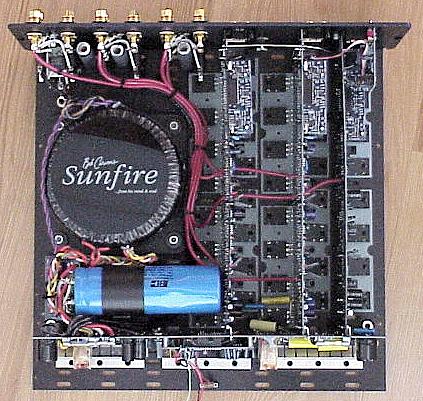

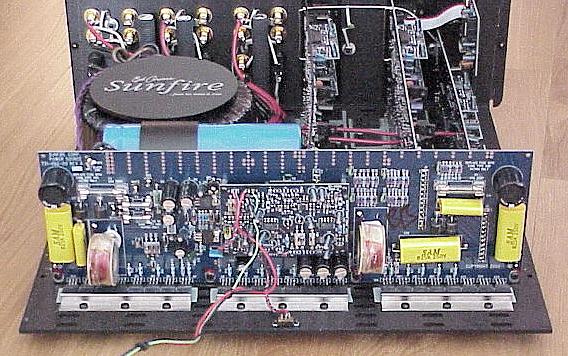
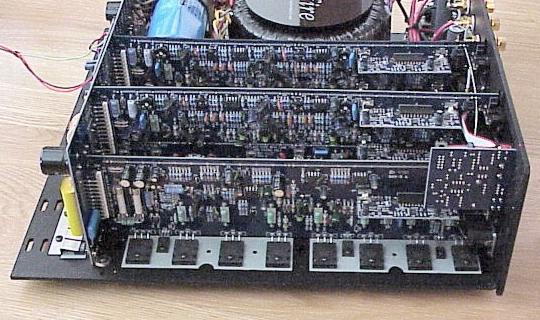
The result is a new rating of 425 watts RMS per channel into 8 Ohms, 20 Hz - 20 kHz, at 0.5% THD, making the Sunfire Cinema Grand Signature one of the most powerful multi-channel power amplifiers in the world.
In our tests, the hum and noise did indeed reach a new low level. It is extremely quiet. This is important with the incredible dynamic range capability that DVD-A and SACD have.
The original Signature was a fine product and a heck of a bargain. The updated version, at $3,750, is even better, and still an excellent buy.
- John E. Johnson, Jr. -
![]()
� Copyright 1999, 2001 Secrets of Home Theater & High
Fidelity
Return to Table of Contents for this Issue.

